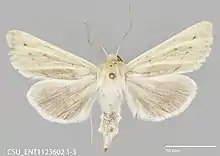Copablepharon viridisparsa
Copablepharon viridisparsa is a moth of the family Noctuidae first described by F. H. Wolley Dod in 1916.[1] It is found from southern California and southern Utah north to southern British Columbia, central Saskatchewan and south-western Manitoba.
| Copablepharon viridisparsa | |
|---|---|
 | |
| Copablepharon viridisparsa gilvum | |
| Scientific classification | |
| Kingdom: | |
| Phylum: | |
| Class: | |
| Order: | |
| Family: | |
| Genus: | |
| Species: | C. viridisparsa |
| Binomial name | |
| Copablepharon viridisparsa Dod, 1916 | |
| Synonyms | |
| |
The wingspan is 38–42 mm. Adults are on wing from June to August depending on the location.
The moths emerge from the pupae with the eggs nearly fully developed, and they are laid within a week or two. Eggs are laid in loose soil in mid-summer, and the larvae hibernate when partly grown, completing development the following spring. The larvae can bury themselves very rapidly if uncovered. They feed above ground at night and bury themselves about 2.5 cm deep in the soil under the host plants during the day.
Pupation occurs in an earthen cell about 5 cm deep in the soil. Adults emerge after three to four weeks.
Subspecies
- Copablepharon viridisparsa viridisparsa Dod, 1916
- Copablepharon viridisparsa hopfingeri (Franclemont, 1954)
- Copablepharon viridisparsa gilvum Crabo & Lafontaine, 2004
- Copablepharon viridisparsa ravum Crabo & Lafontaine, 2004
References
- Savela, Markku, ed. (May 13, 2020). "Copablepharon viridisparsa Dod, 1916". Lepidoptera and Some Other Life Forms. Retrieved November 13, 2020.
External links
- Anweiler, G. G. (February 11, 2005). "Species Details Copablepharon viridisparsa". University of Alberta Museums. E.H. Strickland Entomological Museum. Retrieved November 13, 2020.
- "933289.00 – 10687 – Copablepharon viridisparsa – Dod, 1916". North American Moth Photographers Group. Mississippi State University. Retrieved November 13, 2020.